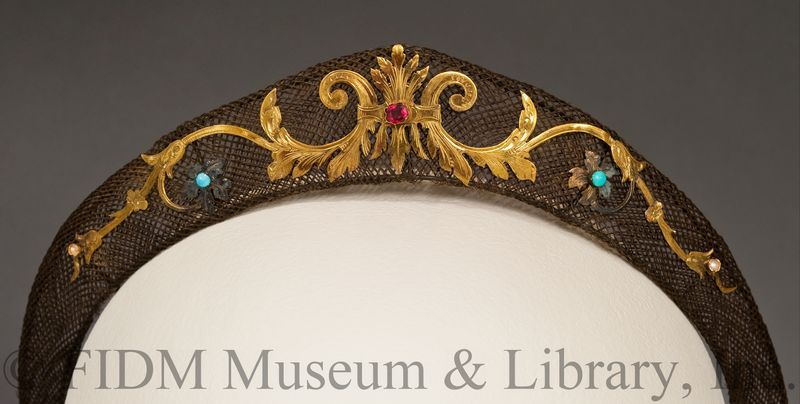Hairwork diadem
 Diadem
Diadem
1875-1900
Bolognese & Son, Jeweler
Gift of Andrea Tice in memory of Carmelita Johnson
2008.46.278AB
This diadem of human hair ornamented with gold and semiprecious stones appears to be a one-of-a-kind accessory. Such a unique headpiece was surely made for a specific person, either from her own hair or from that of a loved one. The use of hair to craft tokens of friendship, love, or mourning goes back centuries and took many forms, including: earrings, necklaces, brooches, rings, or, in this case, a headdress. The wired shape and metallurgic techniques of the golden appliqué at center suggest this diadem dates to the last quarter of the nineteenth century. Its floral symbolism and stone selection signify that it was worn at a time of mourning: the thorny acanthus leaves set with a mauve garnet connote the pain of separation at death, the turquoise-mounted flowers on either side are forget-me-nots, and the pearl trimmed buds represent the tears of the gods.1
This diadem was donated to the FIDM Museum along with its accompanying white satin case. Made for this piece, the case is stamped with the name of the jeweler who created it: Bolognese & Son, Bologna, Italy. Though some hairwork was created by amateur practitioners, the more sophisticated pieces were typically created by jewelers who offered hairwork as part of a larger array of adornments. Even if we didn't have the case, the quality of the workmanship and the precious embellishment of this diadem would suggest that it was the work of a skilled jeweler.
For jewelers, hairwork was a logical, and lucrative, extension of their main business. Hair, the primary component, could be purchased relatively cheaply in major US cities or from European capitals. Once a stock of hair was acquired, inexpensive metals were used as dimensional foundations for intricate adornments. The diadem pictured here features a criss-cross pattern of woven hair carefully stretched over a wire frame. Embellishment of gold or semi-precious stones added additional expense, but this cost was within the means of well-to-do customers.
For those brave souls who wanted to try their hand at creating their own hairwork remembrance, instructional manuals provided diagrams, charts, and detailed directions. The nineteenth-century manual below also offers a catalog of metal frames for creating earrings, bracelets, and other hairwork jewelry. It even includes tips on creating false hairpieces!
1 Bruce-Mitford, Miranda. The Illustrated Book of Signs & Symbols (New York: DK Publishing, 1996) 38.